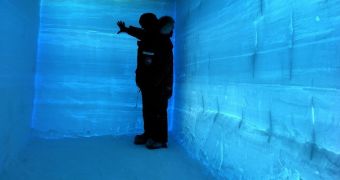Scientists conducting studies at the West Antarctic Ice Sheet Divide (WAIS) managed to take their drill bits to a depth of up to 3,331 meters (10,928 feet) beneath the surface, one of the most impressive depths reached in a scientific study.
The goal of the investigation is to collect ice core samples, that could then be used to analyze the climate our planet experienced over the past 100,000 years. The deeper scientists go into the ices, the more data they can infer.
In spite of this massive achievement, the project is not yet completed. Over the next couple of years, scientists will continue to drill beneath the ices, sampling the ice cores, and logging boreholes.
This will be done with the express purpose of studying the climate record, and gaining a deeper, fuller understanding of what went on in the past. Another objective is to collect sufficient data to determine what caused climate changes and why.
The research, funded by the US National Science Foundation (NSF), began more than six years ago. Since then, researchers have been digging around the clock, hoping to go as deep as possible.
Experts chose to dig at the WAIS Divide site, hoping that the ice they recover and analyze from those locations would hold the most relevant clues about what went on in Earth's climate past.
Establishing former greenhouse gas concentrations is also a priority. Today, GHG levels are increasing fast, and climate models seeking to simulate what will go on in the future could be significantly refined by the upcoming discoveries.
Knowing how the planet reacted when it dealt with the same time of situations in the past would be of tremendous use in these models, as a frame of references. This is why this Friday saw the US team created its deepest hole in the ice ever.
The 3,331-meter drill hole is the second-largest ever, second one to that which the Russian drilled back in the 1990s at the Vostok Station, in the Antarctic. The new location can be found some 966 kilometers (600 miles) away from the South Pole.
“By improving our understanding of how natural changes in greenhouse gas influenced climate in the past, the science community will be able to do a better job of predicting future climate changes caused by the emissions of greenhouse gases by human activity,” explains Kendrick Taylor.
“This location was selected because it is the best place on the planet to determine how greenhouse gases have changed during the last 100,000 years,” adds the expert, who is the chief scientist for the WAIS Divide Ice Core Project.
“We still have two more field seasons of work to complete the project, and reaching this goal should allow us to complete the project on schedule,” adds NSF Office of Polar Programs (OPP) program director Julie Palais.
“In addition, we are hoping to get as long a record as possible from this site, and getting all of the ice we planned on this year will allow the science community to do the work that they are funded to do. Drilling the ice core is just the first step in the process, albeit a very important one,” she adds.
The OPP funds this investigation, primarily through its Antarctic Glaciology Program.

 14 DAY TRIAL //
14 DAY TRIAL //